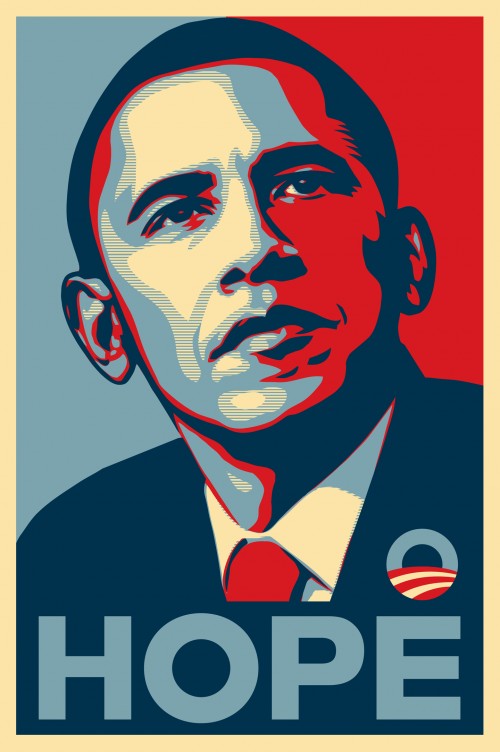 It was the most iconic image of the Obama presidential campaign-a bold, red, white and blue portrait of Barack Obama gazing skyward with the word "HOPE" emblazoned across the bottom. The image was everywhere from posters and stickers to t-shirts and billboards. There was even a web application called Obamicon.me that allowed users to upload their own photos and create a personalized image in the style of the Obama "HOPE" poster.
It was the most iconic image of the Obama presidential campaign-a bold, red, white and blue portrait of Barack Obama gazing skyward with the word "HOPE" emblazoned across the bottom. The image was everywhere from posters and stickers to t-shirts and billboards. There was even a web application called Obamicon.me that allowed users to upload their own photos and create a personalized image in the style of the Obama "HOPE" poster.Designed by popular street artist Shepard Fairey, the poster sold hundreds of thousands of copies and even became part of the National Portrait Gallery's permanent collection. But for the past year, the image has been the center of an ongoing copyright controversy. In February, the Associated Press announced that the image was based on one of its photos shot in 2006, and since its use required permission, the news agency is entitled to credit and compensation. In response, Fairey filed a pre-emptive lawsuit against the AP claiming that he was protected from copyright infringement by the doctrine of "fair use," which allows for the limited use of copyrighted material without permission, depending on certain factors including how much of the original was used, how much it was transformed and whether or not the new work hurts the value of the original.
The AP finally countersued for copyright infringement in March, while Mannie Garcia, the photographer who took the original photo, filed a motion of his own claiming that the copyright actually belonged to him. As preparations for the case continued, one of the central disputes became a question of which photo Fairey had actually used as the basis of the poster. While Fairey claimed that he had altered a photo of Obama seated next to actor George Clooney, the AP claimed that he used a photo of Obama alone that was virtually identical to the poster image. In October, Fairey admitted that he had been "mistaken" and that he had not only used the photo that the AP claimed he did, but had falsified and destroyed evidence in an effort to corroborate his original claim.
While Fairey's admission of wrongdoing may have severely undermined his argument (i.e., if Fairey did not do any significant alterations to the photo, fair use may not apply), the case may still serve as an interesting bellwether for copyright rules in the digital age. For organizations like the AP, information is their livelihood. But with so much information so easily attainable (Fairey discovered the photo using a simple Google image search), the question of ownership of intellectual property and the policing of copyright infringement becomes more complicated.
So far, the AP has been aggressive in its fight to protect its content and this is not the first time it has been involved in the fair use debate. In 2008, the news agency threatened legal action against various blogs for using its material without permission. Many in the blogging community labeled the AP a bully and claimed fair use while others boycotted the news organization and refused to use its stories on their sites altogether. While the AP seems to have backed down from taking legal action so far, it is adding software to its content that would track its use and monitor the web for any possible copyright violations.
